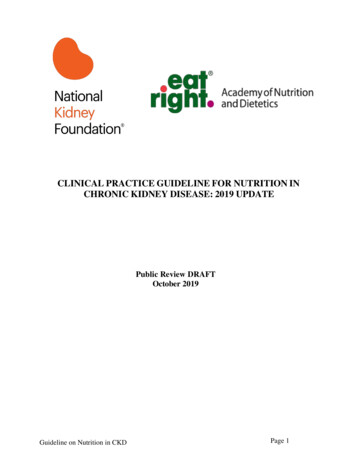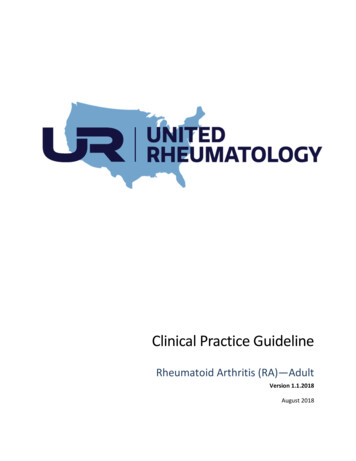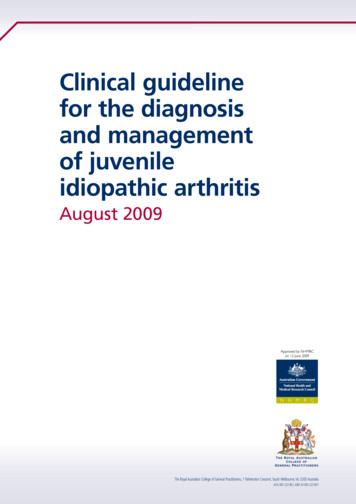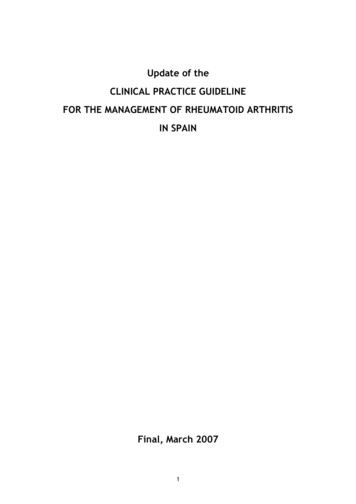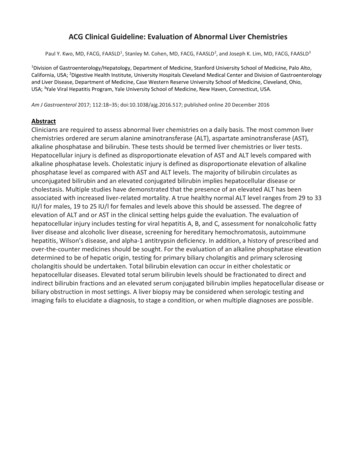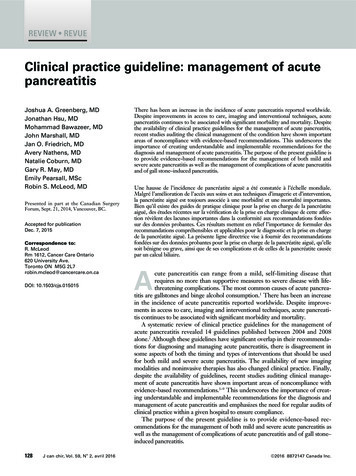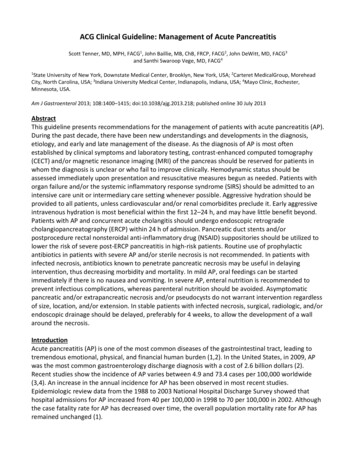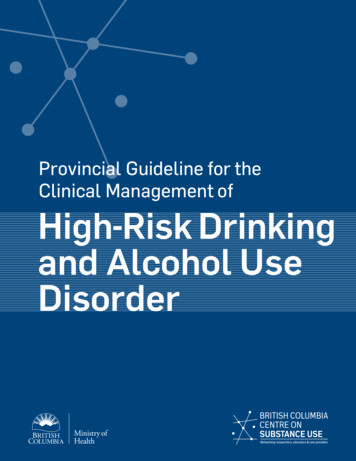
Transcription
Clinical Nutrition 36 (2017) 623e650Contents lists available at ScienceDirectClinical Nutritionjournal homepage: http://www.elsevier.com/locate/clnuESPEN guideline: Clinical nutrition in surgeryArved Weimann a, *, Marco Braga b, Franco Carli c, Takashi Higashiguchi d,Martin Hübner e, Stanislaw Klek f, Alessandro Laviano g, Olle Ljungqvist h, Dileep N. Lobo i,Robert Martindale j, Dan L. Waitzberg k, Stephan C. Bischoff l, Pierre Singer maKlinik für Allgemein-, Viszeral- und Onkologische Chirurgie, Klinikum St. Georg gGmbH, Delitzscher Straße 141, 04129 Leipzig, GermanySan Raffaele Hospital, Via Olgettina 60, 20132 Milan, ItalycDepartment of Anesthesia of McGill University, School of Nutrition, Montreal General Hospital, Montreal, CanadadDepartment of Surgery & Palliative Medicine, Fujita Health University School of Medicine, Toyoake, Aichi, JapaneService de chirurgie visc erale, Centre Hospitalier Universitaire Vaudois (CHUV), Rue du Bugnon 46, 1011 Lausanne, SwitzerlandfGeneral and Oncology Surgery Unit, Stanley Dudrick's Memorial Hospital, 15 Tyniecka Street, 32-050 Skawina, Krakau, Polandg Nutrizione Clinica, Viale dell'Universita , 00185 Roma, ItalyDipartimento di Medicina Clinica, Universita “La Sapienza” Roma, UOD Coordinamento Attivitah Department of Surgery, Faculty of Medicine and Health, OrebroUniversity, Orebro,SwedeniGastrointestinal Surgery, National Institute for Health Research Nottingham Digestive Diseases Biomedical Research Unit, Nottingham University Hospitalsand University of Nottingham, Queen's Medical Centre, Nottingham NG7 2UH, UKjOregon Health & Science University, 3181 SW Sam Jackson Park Rd., L223A, Portland, OR 97239, USAkDepartment of Gastroenterology, School of Medicine, LIM-35, University of Sao Paulo, Ganep e Human Nutrition, Sao Paulo, Brazill hrungsmedizin (180), Universita t Hohenheim, 70593 Stuttgart, GermanyInstitut für ErnamInstitute for Nutrition Research, Rabin Medical Center, Beilinson Hospital, Petah Tikva 49100, Israelba r t i c l e i n f os u m m a r yArticle history:Received 11 February 2017Accepted 13 February 2017Early oral feeding is the preferred mode of nutrition for surgical patients. Avoidance of any nutritionaltherapy bears the risk of underfeeding during the postoperative course after major surgery. Consideringthat malnutrition and underfeeding are risk factors for postoperative complications, early enteral feedingis especially relevant for any surgical patient at nutritional risk, especially for those undergoing uppergastrointestinal surgery. The focus of this guideline is to cover nutritional aspects of the Enhanced Recovery After Surgery (ERAS) concept and the special nutritional needs of patients undergoing majorsurgery, e.g. for cancer, and of those developing severe complications despite best perioperative care.From a metabolic and nutritional point of view, the key aspects of perioperative care include: integration of nutrition into the overall management of the patient avoidance of long periods of preoperative fasting re-establishment of oral feeding as early as possible after surgery start of nutritional therapy early, as soon as a nutritional risk becomes apparent metabolic control e.g. of blood glucose reduction of factors which exacerbate stress-related catabolism or impair gastrointestinal function minimized time on paralytic agents for ventilator management in the postoperative period early mobilisation to facilitate protein synthesis and muscle functionThe guideline presents 37 recommendations for clinical practice. 2017 European Society for Clinical Nutrition and Metabolism. Published by Elsevier Ltd. All rightsreserved.Keywords:SurgeryERASPerioperative nutritionEnteral nutritionParenteral nutritionPrehabilitation* Corresponding author. Fax: þ49 341 909 2234.E-mail addresses: Arved.Weimann@sanktgeorg.de (A. Weimann), braga.marco@hsr.it (M. Braga), franco.carli@mcgill.ca (F. Carli), t-gucci30219@herb.ocn.ne.jp(T. Higashiguchi), Martin.Hubner@chuv.ch (M. Hübner), klek@poczta.onet.pl (S. Klek), alessandro.laviano@uniroma1.it (A. Laviano), olle.ljungqvist@oru.se, olle.ljungqvist@ki.se (O. Ljungqvist), dileep.lobo@nottingham.ac.uk (D.N. Lobo), martindr@ohsu.edu (R. Martindale), dan@ganep.com.br (D.L. Waitzberg), Bischoff.Stephan@unihohenheim.de (S.C. Bischoff), psinger@clalit.org.il, pierre.singer@gmail.com (P. 130261-5614/ 2017 European Society for Clinical Nutrition and Metabolism. Published by Elsevier Ltd. All rights reserved.
624A. Weimann et al. / Clinical Nutrition 36 (2017) 623e650Important abbreviations and termsBMENERASESPENbiomedical endpointsenteral nutrition (enteral tube feeding)enhanced recovery after surgeryEuropean Society for Clinical Nutrition andMetabolismHEhealth care economy endpointIEintegration of classical and patient-reportedendpointsONSoral nutritional supplementsPNparenteral nutritionQLquality of lifeTFtube feedingNormal food/normal nutrition normal diet as offered by thecatering system of a hospitalincluding special dietsPerioperative nutrition period starting prior to surgery fromhospital admission until dischargeafter surgery1. Preliminary remarks e Principles of metabolic andnutritional careIn order to make proper plans for the nutritional support ofpatients undergoing surgery, it is essential to understand the basicchanges in metabolism that occur as a result of injury, and that acompromised nutritional status is a risk factor for postoperativecomplications. Starvation during metabolic stress from any type ofinjury differs from fasting under physiological conditions [1]. Surgery itself leads to inflammation corresponding with the extent ofthe surgical trauma, and leads to a metabolic stress response. Toachieve appropriate healing and functional recovery (“restitutio adintegrum”) a metabolic response is necessary, but this requiresnutritional therapy especially when the patient is malnourishedand the stress/inflammatory response is prolonged. The negativeeffect of long term caloric and protein deficits on outcome forcritically ill surgical patients has been shown again recently [2]. Thesuccess of surgery does not depend exclusively on technical surgical skills, but also on metabolic interventional therapy, taking intoaccount the ability of the patient to carry a metabolic load and toprovide appropriate nutritional support. In patients with cancer,management during the perioperative period may be crucial forlong-term outcome [3,4].Surgery, like any injury, elicits a series of reactions includingrelease of stress hormones and inflammatory mediators, i.e. cytokines. The cytokine response to infection and injury, the so-called“Systemic Inflammatory Response Syndrome”, has a major impacton metabolism. The syndrome causes catabolism of glycogen, fatand protein with release of glucose, free fatty acids and amino acidsinto the circulation, so that substrates are diverted from theirnormal purpose of maintaining peripheral protein (especiallymuscle) mass, to the tasks of healing and immune response [5,6].The consequence of protein catabolism is the loss of muscle tissuewhich is a short and long-term burden for functional recoverywhich is considered the most important target [7]. In order to spareprotein stores, lipolysis, lipid oxidation, and decreased glucoseoxidation are important survival mechanisms [8]. Nutritionaltherapy may provide the energy for optimal healing and recovery,but in the immediate postoperative phase may only minimallycounteract muscle catabolism, or not at all. To restore peripheralprotein mass the body needs to deal with the surgical trauma andpossible infection adequately. Nutritional support/intake andphysical exercise are prerequisites to rebuild peripheral proteinmass/body cell mass.Patients undergoing surgery may suffer from chronic low-gradeinflammation as in cancer, diabetes, renal and hepatic failure [9].Other non-nutritional metabolic factors interfering with anadequate immune response have to be taken into account and,whenever possible, corrected or ameliorated before surgery. Theseare diminished cardio-respiratory organ function, anaemia, acuteand chronic intoxications (e.g. alcohol, recreational drugs), medicaltreatment with anti-inflammatory and cytotoxic drugs.The surgeon has to balance the extent of surgery according tonutritional state, inflammatory activity and anticipated hostresponse. Severe pre-existing inflammation and sepsis influencehealing negatively (wounds, anastomoses, immune function, etc.)but also decrease the benefit of nutritional therapy. Severelymalnourished patients may exhibit an adynamic form of sepsiswith hypothermia, leukopenia, somnolence, impaired woundhealing and pus production, altogether leading to slow deterioration and mortality. In this situation nutritional therapy will notmaintain or build up muscle mass but may restore an adequatestress response, promoting the chances of recovery. Awareness forthe impaired inflammatory stress response means limiting theextent of the surgical trauma and may lead to uneventful recovery.Severely compromised patients should receive perioperativenutritional therapy of longer duration or when acute intervention isrequired, surgery should be limited or minimally invasiveinterventional techniques should be preferred to relieve infection/ischaemia.In order to optimize the mildly malnourished patient shortterm (7e10 days) nutritional conditioning has to be considered.In severely malnourished patients longer periods of nutritionalconditioning are necessary and this should be combined withresistance exercise. In the truly infected patient immediatelydealing with the focus of sepsis (“source control”) should havepriority and no major surgery should be performed (risky anastomoses, extensive dissections etc.). Definitive surgery should beperformed at a later stage when sepsis has been treated adequately.In elective surgery it has been shown that measures to reducethe stress of surgery can minimize catabolism and support anabolism throughout surgical treatment and allow patients to recoversubstantially better and faster, even after major surgical operations.Such programmes for Fast Track surgery [10] later developed intoEnhanced Recovery after Surgery (ERAS). A series of componentsthat combine to minimize stress and to facilitate the return offunction have been described: these include preoperative preparation and medication, fluid balance, anaesthesia and postoperativeanalgesia, pre- and postoperative nutrition, and mobilization[5,11e13]. The ERAS programmes have now become a standard inperioperative management that has been adopted in many countries across several surgical specialties. They were developed incolonic operations [11,14e17] and are now being applied to allmajor operations. ERAS programmes have been also successful inpromoting rapid “functional” recovery after gastrectomy [18],pancreatic resections [19,20], pelvic surgery [21,22], hysterectomy[23], gynaecologic oncology [24]. In times of limitations in healthcare economy ERAS is also a reasonable contribution for the purpose of saving resources [25]. ERAS protocols have been also shownto be safe and beneficial in the elderly [26]. High adherence to ERASprotocols may be associated with improved 5-year cancer specificsurvival after major colorectal surgery [4].
A. Weimann et al. / Clinical Nutrition 36 (2017) 623e650As a key component of ERAS, nutritional management is aninter-professional challenge. The ERAS programmes also include ametabolic strategy to reduce perioperative stress and improveoutcomes [12]. While early oral feeding is the preferred mode ofnutrition, avoidance of any nutritional therapy bears the risk ofunderfeeding during the postoperative course after major surgery.Keeping in mind that the nutritional status is a risk factor forpostoperative complications, this is especially relevant for patientsat nutritional risk and those undergoing upper gastrointestinal (GI)surgery. For this reason, ERAS guidelines recommend liberal subscription of oral supplements pre- and postoperatively. EquallyERAS protocols support early oral intake for the return of gutfunction.From a metabolic and nutritional point of view, the key aspectsof perioperative care include: integration of nutrition into the overall management of thepatient avoidance of long periods of preoperative fasting re-establishment of oral feeding as early as possible aftersurgery start of nutritional therapy early, as soon as a nutritional riskbecomes apparent metabolic control e.g. of blood glucose reduction of factors which exacerbate stress-related catabolismor impair gastrointestinal function minimize time on paralytic agents for ventilator management inthe postoperative period early mobilisation to facilitate protein synthesis and musclefunction.1.1. Nutrition therapyNutrition therapy. Synonym: nutritional support is defined according to the European Society for Clinical Nutrition and Metabolism (ESPEN) [27,28]:Nutrition therapy is the provision of nutrition or nutrients eitherorally (regular diet, therapeutic diet, e.g. fortified food, oral nutritional supplements) or via enteral nutrition (EN) or parenteralnutrition (PN) to prevent or treat malnutrition. “Medical nutritiontherapy is a term that encompasses oral nutritional supplements,enteral tube feeding (enteral nutrition) and parenteral nutrition”[27]. Enteral and parenteral nutrition have traditionally been calledartificial nutritional support. Nutrition therapies are individualizedand targeted nutrition care measures using diet or medicalnutrition therapy. Dietary advice or nutritional counselling can bepart of a nutrition therapy.In the surgical patient, the indications for nutritional therapy areprevention and treatment of catabolism and malnutrition. This affects mainly the perioperative maintenance of nutritional state inorder to prevent postoperative complications [29]. Therapy shouldstart as a nutritional risk becomes apparent. Criteria for the successof the “therapeutic” indication are the so-called “outcome” parameters of mortality, morbidity, and length of hospital stay, whiletaking into consideration economic implications. The improvementof nutritional status and functional recovery including quality of lifeare most important nutritional goals in the late postoperativeperiod.Nutrition therapy may be indicated even in patients withoutobvious disease-related malnutrition, if it is anticipated that thepatient will be unable to eat or cannot maintain appropriate oralintake for a longer period perioperatively. In these situations,nutrition therapy may be initiated without delay. Altogether, it isstrongly recommended not to wait until severe disease-related625malnutrition has developed, but to start nutrition therapy early,as soon as a nutritional risk becomes apparent.Nutritional care protocols for the surgical patient must include a detailed nutritional and medical history that includes bodycomposition assessment a nutrition intervention plan an amendment of the intervention plan, where appropriate clear and accurate documentation assessment of nutritional andclinical outcome resistance exercise whenever possibleTherefore, as a basic requirement a systematic nutritional riskscreening (NRS) has to be considered in all patients on hospitaladmission [30]. The items of the NRS comprise BMI 20.5 kg/m2,weight loss 5% within 3 months, diminished food intake, andseverity of the disease. In older adults comprehensive geriatricassessment is necessary and should definitely include NRS [31].In order to improve oral intake documentation of food intake isnecessary and nutritional counselling should be provided asneeded. Oral nutritional supplements (ONS) and EN (tube feeding)as well as PN offer the possibility to increase or to ensure nutrientintake in case of insufficient oral food intake.1.2. Preoperative nutritional care1.2.1. Nutritional “metabolic” risk and disease-related malnutritionAssessment before surgery means risk assessment according topathophysiology [32]. Severe undernutrition has long been knownto be detrimental to outcome [33e36]. Malnutrition is generallyconsidered to be associated with starving and lack of food. Itspresence in the Western world with an increasing percentage ofobese people is frequently neither realized nor well understood.Disease Related Malnutrition (DRM) is more subtle than suggestedby the World Health Organization (WHO) definition of undernutrition with a body mass index (BMI) 18.5 kg/m2 (WHO) [28,37].Disease related weight loss in patients who are overweight is notnecessarily associated with a low BMI. However, this weight lossresults in changes in body composition with a loss of fat free massinducing a “metabolic risk” which has to be kept in mind for patients undergoing major surgery with special regard to cancer.Additionally, chronic low-grade inflammation may be a componentof malnutrition [9].ESPEN has recently defined diagnostic criteria for malnutritionaccording to two options [28] option 1: BMI 18.5 kg/m2 option 2: combined: weight loss 10% or 5% over 3 months andreduced BMI or a low fat free mass index (FFMI).Reduced BMI is 20 or 22 kg/m2 in patients younger and olderthan 70 years, respectively. Low FFMI is 15 and 17 kg/m2 infemales and males, respectively.Because DRM is frequently not recognized and thereforeuntreated, metabolic factors will usually not be considered for thecritical analysis of surgical morbidity and outcome. In traditionalsurgical care many retrospective and prospective studies (References in ESPEN guidelines 2006, [38]) have shown clearly theprognostic influence of nutritional status on complications andmortality. A systematic review of ten studies revealed a validatednutritional tool a predictor for length of hospital stay in gastrointestinal cancer patients requiring surgery [39]. DRM is also relevantfor outcome after organ transplantation (see references [38]). Datafrom the European “NutritionDay” in about 15,000 patients clearly
626A. Weimann et al. / Clinical Nutrition 36 (2017) 623e650showed that “metabolic risk” is a factor for hospital mortality, withspecial focus on the elderly [40].According to the prospective data from a multicentre trial, mostpatients at risk will be found in hospital in the departments ofsurgery, oncology, geriatrics, and intensive care medicine. Theunivariate analysis revealed significant impact for the hospitalcomplication rate: severity of the disease, age 70 years, surgeryand cancer [41]. Bearing in mind the demographic development inthe Western world, surgeons will have to deal with an increasedrisk of developing complications in the elderly undergoing majorsurgery for cancer.The metabolic risk associated with DRM can be detected easilyby the “Nutritional Risk Score” [30]. This tool has been validatedprospectively in recent studies for surgical patients as well [41,42].Recently, one study reported that a lower food intake beforehospital admission alone was an even better risk predictor thanNRS [43]. A systematic review of 15 studies on elderly generalsurgery patients ( 65 years) from 1998 to 2008 revealed thatweight loss and serum albumin concentration were predictive parameters for postoperative outcome [44]. This has been confirmedin a recent cohort study of patients undergoing major uppergastrointestinal surgery [7].For clinical practice these data emphasize:evidence supporting prehabilitation to mitigate the side effects oftherapy in patients with cancer [55]. Meaningful changes in functional capacity take 4e5 weeks of prehabilitation and were recentlyshown for patients undergoing liver resection [56]. Patients withlow functional and physiological reserve such as the elderly, frail,sarcopenic and cancer patients could benefit more from prehabilitation than other patient populations. This possibility needsto be studied. Further studies with special regard to elderly cancerpatients are needed to determine the impact of prehabilitation aspart of the preoperative optimization on postoperative outcome(complications, length of hospital stay, readmission rate).“Metabolic conditioning” of the patient focuses on preventionand treatment of insulin resistance, which is also a measure toreduce complications after major surgery. Preoperative carbohydrates may reduce insulin resistance, prevent hypoglycaemia andmay reduce stress. Focussing on the magnitude of stress-inducedinflammation and the ability of the patient to generate anadequate host response has led to the concept of “immunonutrition”. So-called “ecoimmunonutrition” using pre- and probioticsaims at the microbiome in the gut and the enhancement of mucosalimmunity [57]. screening for malnutrition (e.g. Nutritional Risk Screening eNRS) on admission or first contact observation and documentation of oral intake regular follow-up of weight and BMI nutritional counsellingTo balance the extent of surgery with the ability of the body todeal with the metabolic load may be a considerable challenge forthe surgeon. This refers to relevant comorbidity with special regardto the cardiopulmonary capacity and the presence of inflammationor even more infection and sepsis. If the extent and risk of surgeryare not tailored to the capacity of the patient to generate anadequate host response, there is a high risk for anastomoticleakage, infectious/septic complications, and mortality.After abdominal surgery postoperative ileus may inhibit earlyoral food intake. Experimental results demonstrate the impact ofintraoperative manipulation and subsequent panenteric inflammation as the cause of dysmotility [58,59]. This emphasizes theadvantages of minimal invasive and gentle surgical technique [60] inorder to minimize the trauma and favours laparoscopic surgery [61].Traditionally, many patients undergoing major gastrointestinalresections receive large volumes of crystalloids intravenously during and after surgery. Excess fluid administration would result inseveral kilos in weight gain and even oedema [62]. This was shownto be a major cause for postoperative ileus and delayed gastricemptying [63] and development of complications [64]. When fluidswere titrated to the amount needed to maintain intravascularvolume, blood pressure and (modest) urine production balance,gastric emptying returned sooner and patients were capable oftolerating oral intake and had bowel movements several daysearlier than those with a strongly positive balance, amounting to8e10 L during operation and the three days after operation [63,64].The surgeon should anticipate the ability of the patient forappropriate postoperative oral feeding. If considerable problemsmay be foreseen, the operation offers a unique chance to create safeaccess for long-term nutrition. Therefore, it may be reasonable toplace a nasojejunal tube or needle catheter jejunostomy (NCJ) forEN at the end of major gastrointestinal surgery.Preoperative serum albumin is a prognostic factor for complications after surgery [7,45e50] and also associated with impairednutritional status. Therefore, albumin may also be considered todefine surgical patients at severe nutritional risk by the presence ofat least one of the following criteria: weight loss 10e15% within 6 monthsBMI 18.5 kg/m2Subjective Global Assessment (SGA) Grade C or NRS 5preoperative serum albumin 30 g/l (with no evidence of hepatic or renal dysfunction).For patients at high risk preoperative conditioning has been atraditional approach to optimize the patient's status before majorelective surgery. After earlier surgery with infectious complications,at least 6 weeks and sometimes longer may be required to restore ametabolic and nutritional state allowing a successful reoperation[51,52]. In case of severe metabolic risk 10e14 days of nutritionaltherapy may be beneficial, but without measurable change in bodycomposition or serum albumin concentration. While this conceptfocuses on EN or PN support only, “prehabilitation” has beenrecently introduced, and is an inter-professional multimodalapproach [5]. The premise of the multimodal prehabilitationapproach with a nutrition and physical exercise component restson their synergy. Regarding the clinical impact of prehabilitationtwo recent meta-analyses concluded that preoperative exercisetherapy contributed to decreased postoperative complication ratesand shortened length of stay in patients undergoing cardiac andabdominal surgery [53,54]. The training of inspiratory muscles wasalso associated with decreased postoperative pulmonarycomplications.While physical activity is the main part of this multimodalprehabilitation programme, other functional reserve factors needto be included, such as adequate nutrition, medical and pharmacological optimization and relaxation techniques. There is strong1.3. Surgery1.4. Postoperative management of metabolism and gut functionInsulin resistance is a response mechanism to starvation predominantly caused by the inhibition of glucose oxidation. It is aprotein sparing evolutional “survival” mechanism [8]. Some degreeof insulin resistance develops after all kinds of surgery, but itsseverity is related to the magnitude of the operation and development of complications e.g. sepsis.
A. Weimann et al. / Clinical Nutrition 36 (2017) 623e650Several measures, with additive effects, may contribute to areduction in insulin resistance, including pain relief [65], continuous epidural analgesia using local anaesthetics [66], and preparation of the patient with preoperative carbohydrates two to threehours before surgery. This has implications for nutritional management since patients with marked insulin resistance cannottolerate feeding without developing hyperglycaemia, necessitatingthe use of insulin to limit hyperglycaemia.Using this approach of preoperative carbohydrate loading andcontinuous epidural analgesia, and immediate postoperative complete enteral feeding in patients undergoing colorectal surgery,postoperative insulin resistance was reduced greatly. Glucoseconcentrations were maintained within the normal range duringfeeding without any exogenous insulin, and nitrogen losses werealso reduced [67]. Another factor that affects tolerance of normalfood or EN directly is postoperative ileus, which may be exacerbated and prolonged by opiates and errors in fluid management[58]. The effect of opioids, used for pain relief, can be avoided orsubstantially minimized in open surgery by the use of epiduralanalgesia instead [10e12]. Nasogastric or nasojejunal decompression does not facilitate the recovery of bowel function or reduce therisk of postoperative complications even after gastrectomy [68].Functional recovery is clearly related to the tolerance of oralfood intake, restored gastrointestinal motility, and mobilization.During the postoperative course, this should be observed carefullyand documented by the surgical team. Vomiting and/or abdominalmeteorism, accompanied by an elevation of inflammatory parameters like C-reactive protein (CRP) may be first signals of acomplicated course e.g. anastomotic leakage or intraabdominalabscess. This has to be excluded by appropriate diagnostic measures. In order to assess metabolic recovery the CRP/Albumin ratiois a promising new prognostic parameter which has to be validatedin the future [69]. Another important parameter is whether thepatient has reached the “turning point” successfully. In uneventfulrecovery after 2e3 days the fluid balance changes from positive tonegative. The inflammatory effect of the surgical trauma leads toincreased capillary escape of fluid, electrolytes and plasma proteinsinto the interstitium, which reverts when inflammation subsidesleading to re-entry of interstitial fluid into the vascular space. Thisleads to overhydration and increased urinary output if patientshave good renal and cardiac function. Interestingly the increase ininterstitial volume and the vascular volume represent the distribution volume of albumin electrolytes and other plasma elements,explaining the rapid decrease in albumin concentration after surgery and increase 3 days after uneventful major surgery. A persistently low, even decreasing or increasing serum albuminconcentration is, therefore, a good parameter of whether recoveryis successful or not [70]. The magnitude of the postoperative systemic inflammatory response shown in the CRP may be evensignificantly associated with long-term outcome after surgery independent of postoperative complications or disease stage [71].1.5. Evidence of nutritional therapyThere is evidence that malnutrition is associated with worseoutcome, and it is evident that major surgical stress and trauma willinduce catabolism. The extent of catabolism is clearly related to themagnitude of surgical stress but also to the outcome. In complexmedical conditions like the perioperative patient undergoing majorsurgery, the geriatric patient or in the critically ill the outcome willbe clearly related to multiple associated factors. Regarding a nutritional intervention an existing effect may be too weak to show significant impact in a prospective controlled randomized study with afeasible number of patients to be included, even in a multicentersetting. However, the combination of the nutritional intervention627with some other therapeutic items as a “treatment bundle” like inthe ERAS programme may show significant benefit [72].The evidence for nutritional therapy interventions in surgicalpatients has been critically assessed in several meta-analyses andCochrane Database Systematic Reviews [73,74]. There is considerable heterogeneity and inconsistency. In many aspects the evidenceis still of low quality and is unconvincing. There are many shortcomings in these studies and subsequent meta-analyses. Most didnot select patients at nutritional risk for inclusion. Of course, thereis need for more well-designed randomized controlled trials (RCTs),sufficiently powered in homog
“Medical nutrition therapy is a term that encompasses oral nutritional supplements, enteral tube feeding (enteral nutrition) and parenteral nutrition” [27]. Enteral and parenteral nutrition havetraditionally been called artificial nutritional support. Nutrition therapies are individualized and targeted nutrition
